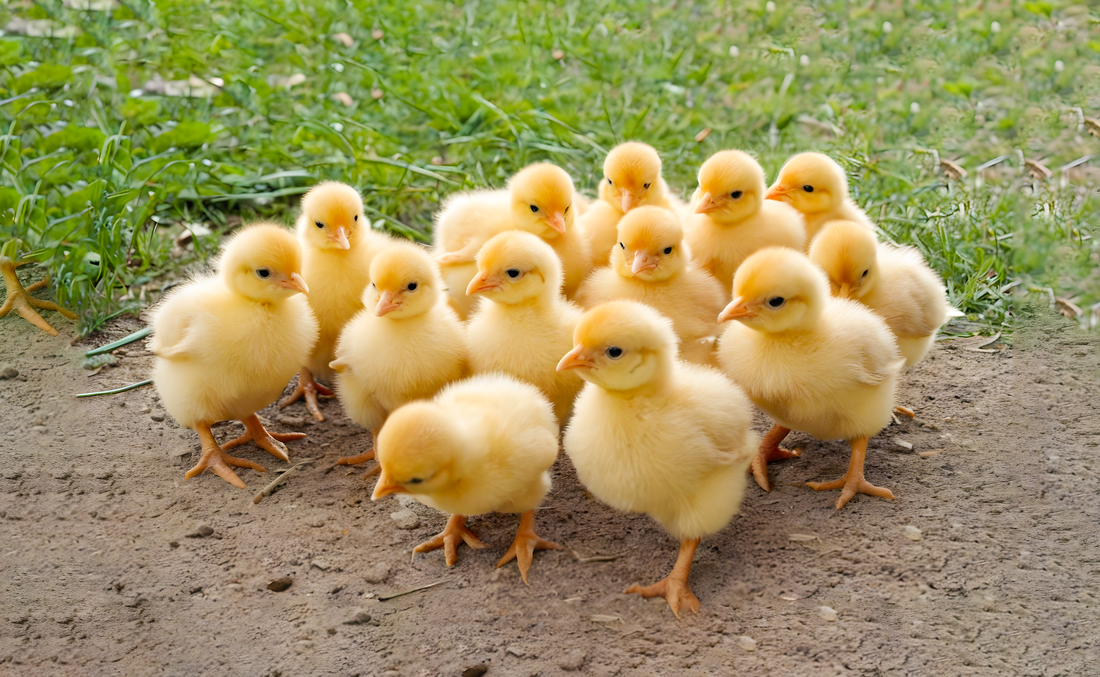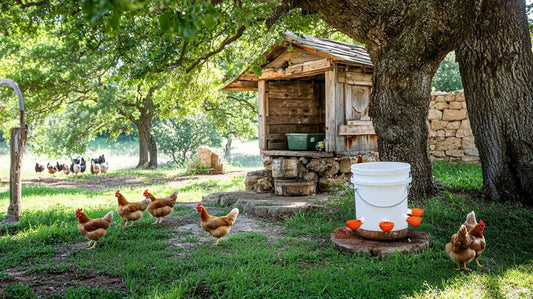Mastering the Art of Raising Happy, Healthy Chicks
Welcome, fellow poultry enthusiasts! Join us on a journey through the intricacies of raising chicks from day-old fluffballs to accomplished egg-layers. In this guide, we'll cover everything from brooding basics to coop transitions, providing you with the essential knowledge to nurture your own feathered flock. Let's embark on this egg-cellent adventure together! 🐣🏡
Step 1: Preparing for the Peep Parade – Chick Brooding Essentials
Raising chicks from day old is a rewarding endeavor that starts with requiring careful preparation and attention to detail. It's imperative to create a nurturing brooder environment to ensure your fluffy newcomers thrive from the get-go and have a healthy development.

- Set Up Your Brooder Box
Think of the brooder box as the cozy chick’s haven where it will serve as the chicks' home for the first few weeks of their lives, providing warmth, safety, and comfort. Choose a spacious container lined with soft bedding (like pine shavings or straw) to mimic the cozy nest they’d find under a mama hen. However, It should be noted that while pine shavings and straw are excellent choices, cedar shavings should be avoided due to the potential release of harmful fumes that can cause respiratory distress or other health issues in chicks.
Ensure there's ample room for the chicks to move around without feeling cramped, with a general recommendation of allowing around half a square foot of space per chick initially, adjusting as they grow. This setup provides the ideal environment for their early development and fosters a sense of security as they embark on their journey to becoming thriving members of your flock.
- Temperature Control
Regulating temperature is paramount to the chicks' health and well-being, as they cannot regulate their body heat effectively. In the absence of a maternal heat source, it's crucial to provide artificial warmth. Invest in a reliable heat source and keep a close eye on the temperature. Aim for a balmy 95°F (35°C) during their first week of life, gradually reducing it by 5°F (2-3°C) per week until they are fully feathered and capable of maintaining their body temperature.
NOTE: When using heat lamps or heating pads, safety should be observed. Secure them properly and monitor them closely to prevent fires. You can also consider using radiant heat brooders as a safer and more energy-efficient option.
- Provide Adequate Ventilation
While warmth is essential, proper ventilation is equally crucial to prevent respiratory issues among chicks. Avoid overcrowding the space with too many chicks and ensure your chick brooder box allows for adequate airflow by incorporating vents or opting for a mesh or wire lid.
However, be mindful to avoid drafts that could chill the chicks.
- Supply Fresh Water and Chick Starter Feed
Hydration and nutrition are the cornerstones of chick health and vitality. From day one, access to clean water and nutrient-rich food is non-negotiable for growing chicks.
To familiarize the chicks with the water, gently guide their beaks to the water upon arrival to introduce them to it. It’s crucial to maintain the water at room temperature at all times and keep it clean and fresh at all times. Avoid drastic changes in water temperature, particularly in extreme climates, as sudden cold water can chill small chicks, while overly warm water can foster bacterial growth. Additionally, use shallow dishes to prevent accidental drowning, and choose a waterer that is securely placed to avoid tipping over.
As for nutrition, opt for a high-quality chick starter feed specifically tailored to meet the dietary needs of growing chicks. Look for a feed that offers a balanced blend of protein, vitamins, and minerals essential for their optimal growth and development. As your chicks mature, transition them to grower feed around 6-8 weeks and layer feed at 18-20 weeks or when they start laying eggs. Also, don’t forget to offer grit when providing treats or different foods to aid digestion.
Investing in reliable waterers and feeders, such as the Lil'Clucker Chick Starter Kit, can streamline the feeding process and ensure your chicks have constant access to food and water. By prioritizing their hydration and nutrition, you're laying the foundation for healthy, thriving chickens in the future.

- Add Entertainment
Step 2: The Coop Caper – Transitioning to the Coop
As your chicks mature, they'll eventually outgrow their brooder and transition to their permanent home in the coop. This stage marks a significant milestone in their journey to adulthood and requires careful planning and preparation.
- Outdoor Orientation
Before making the move to the coop, it's essential to introduce your chicks to their new environment gradually. Take them on supervised field trips to the coop and yard, allowing them to explore and familiarize themselves with their future home. This process helps reduce stress and anxiety and promotes a smooth transition. Encourage them to explore their new surroundings and learn the ropes at their own pace.

- Gradual Introductions
Transitioning chicks from the brooder to the coop should be a gradual process to minimize disruption and ensure their safety and well-being. Start by allowing them to spend short periods of time in the coop during the day, gradually increasing the duration as they become more comfortable and familiar with their environment. This approach helps them adjust to the new sights, sounds, and smells of their surroundings while still providing the security of the brooder as needed.
- Ensure Cozy Accommodations
Before moving your chicks into the coop full-time, it's essential to ensure that their new home is safe, secure, and comfortable. Check for any potential hazards or escape routes, and make any necessary modifications to prevent predators from gaining access. Ensure you provide adequate roosting space, nesting boxes, and ventilation to keep your chickens healthy and happy.
For more detailed guidance on designing the perfect chicken coop for your feathered friends, check out From Clucks to Comfort: The Art of Designing an Ideal Chicken Coop to ensure your feathered friends have the best possible living conditions.

-
Monitor Their Progress
As your chicks settle into their new home, it's crucial to monitor their progress closely and adjust your care routine as needed. Keep an eye on their behavior, appetite, and overall health, and be prepared to make any necessary adjustments to their environment or care regimen. Address any concerns promptly, ensuring they receive the care and attention they need to thrive in their new environment.
By staying vigilant and responsive to their needs, you can help ensure a smooth transition to coop life and set the stage for a lifetime of happy, healthy chickens.
In addition to proper care, remember the importance of gentle handling and socialization for your chicks. Spend time with them regularly, talking softly and offering treats to build trust and friendliness. This helps them become comfortable with human interaction, reducing stress and promoting positive behavior as they grow.
By following these steps and providing a nurturing environment, you'll set your chicks on the path to becoming healthy, happy members of your flock. With proper care and attention, they'll soon be laying eggs and delighting you with their antics for years to come!
Congratulations, you've successfully navigated the peep-to-coop journey and raised a flock of happy, healthy chickens ready to rule the roost! Remember to embrace the chaos, cherish the cuteness, and enjoy the egg-cellent rewards of your hard work. Happy chickening! 🐣🐔





